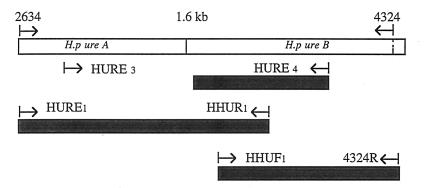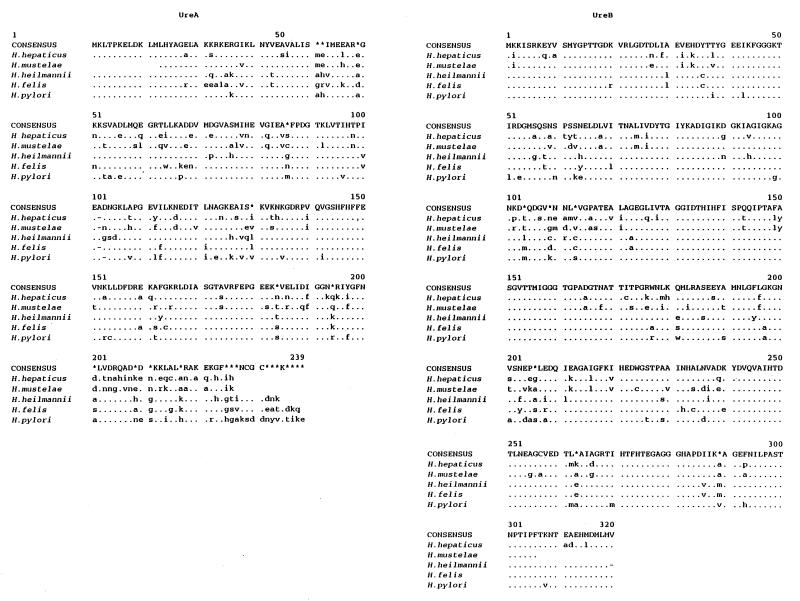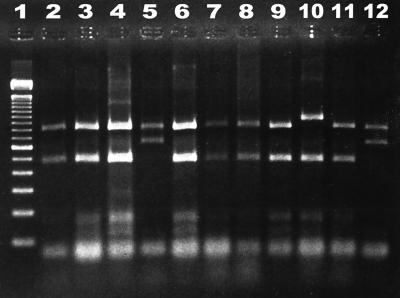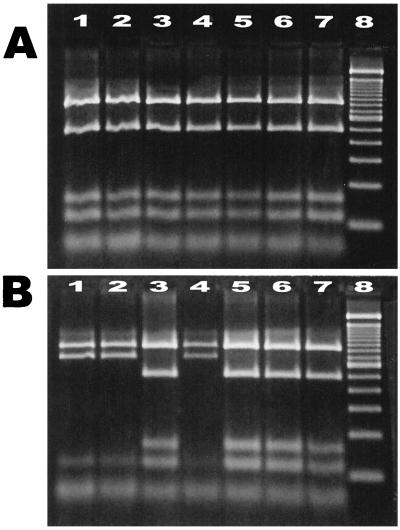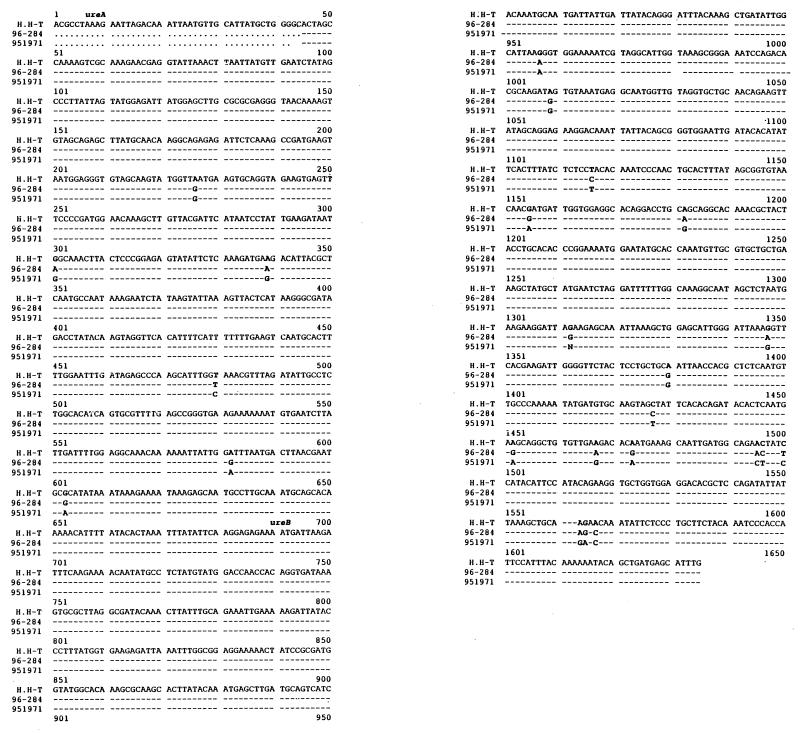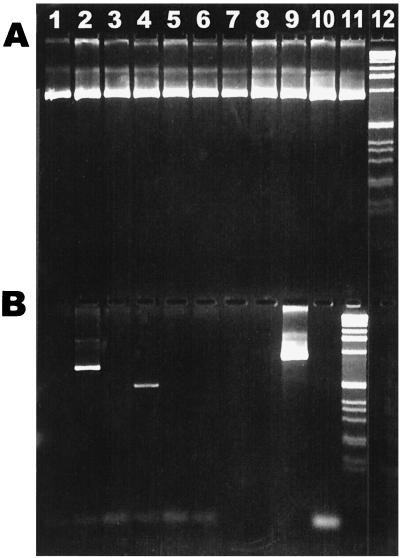Abstract
Infection with Helicobacter hepaticus causes chronic active hepatitis in certain strains of mice and is associated with hepatocellular carcinoma in A/JCr mice. Like the gastric helicobacters, H. pylori and H. mustelae, H. hepaticus possesses a high level of urease activity. However, the H. hepaticus urease structural gene sequences have not been previously determined, and the role of the urease enzyme in colonization and in pathogenesis is not known. PCR was used to amplify a portion of the urease structural genes from H. hepaticus genomic DNA. Amplified DNA fragments were cloned, and the nucleotide sequence was determined. The deduced amino acid sequence of the partial H. hepaticus ureA gene product was found to exhibit 60% identity and 75% similarity to the predicted H. pylori UreA. The deduced amino acid sequence of a partial H. hepaticus ureB gene product exhibited 75% identity and 87% similarity to the predicted H. pylori UreB. Diversity among H. hepaticus isolates was evaluated by means of a restriction fragment length polymorphism (RFLP) assay. The 1.6-kb fragments within the ureAB open reading frames, amplified from 11 independent isolates, were digested with the restriction endonuclease HhaI. Three distinct RFLP patterns were observed. Identical RFLP profiles were noted in sequential isolates of one strain of H. hepaticus during an 18 month in vivo colonization study, suggesting that the urease genes of H. hepaticus are stable. The urease genes among H. hepaticus strains were also well conserved, showing 98.8 to 99% nucleotide sequence identity among three isolates analyzed. These findings indicate that H. hepaticus has urease structural genes which are homologous to those of the gastric Helicobacter species and that these gene sequences can be used in a PCR and RFLP assay for diagnosis of this important murine pathogen.
The genus Helicobacter is a group of microaerobic gram-negative spiral to curved bacteria isolated from the stomachs and intestines of humans and animals. The type species of the genus, Helicobacter pylori, has been recognized in humans as the most common cause of chronic gastritis and has been unambiguously implicated in the pathogenesis of peptic ulcer disease and gastric cancer (4, 10, 38, 40). H. mustelae, H. felis, and H. heilmannii are closely related organisms which have been isolated from the stomachs of mammalian species. Each of these species causes various degrees of gastritis in their respective hosts (18, 19, 21, 22).
Infection with H. hepaticus causes chronic active hepatitis in mice and is associated with hepatocellular carcinoma in A/JCr mice (17, 20, 23). Infection with H. hepaticus has also been linked to inflammatory bowel disease in certain immunodeficient strains of mice as well as in A/JCr mice (6, 20, 51, 52).
Like several other murine Helicobacter spp. which colonize the lower intestine, H. hepaticus expresses an active urease (18). Whereas the role of urease expression by Helicobacter spp. in intestinal and hepatobiliary colonization has not been determined, the production of urease has been shown to be important in the survival of H. pylori in the human gastric mucosa (10, 33–35). This enzyme hydrolyzes urea, releasing ammonia, which may allow survival of the organism at a low pH. The contribution of H. pylori urease to pathogenesis and to the ability to colonize the stomach at acidic pHs has been assessed by utilizing urease-negative isogenic mutant strains in colonization experiments (15, 27, 48, 49). Urease-negative mutant strains of H. pylori are unable to colonize the gastric mucosa of gnotobiotic piglets at a normal physiological pH (14). The urease-negative mutant of H. pylori also lacks the ability to colonize the stomach of nude mice (49). Similar studies were conducted with urease-negative H. mustelae isogenic mutants. These mutants also fail to colonize the gastric mucosa of ferrets (3). However, Eaton and Krakowka showed that H. pylori urease-negative mutants colonize gastric mucosal explants, derived from neonatal germfree piglets, as efficiently as the wild-type strains do, suggesting that the intact host environment is a prerequisite for urease-dependent colonization (15). In addition, urease consistently elicits an immune response in the host and this immunodominant protein has been used to diagnose H. pylori infection (47).
It has been previously reported that the urease from H. pylori exhibits a peak of activity at an acidic pH, which is not observed for the urease from H. muridarum, another murine Helicobacter species that colonizes the bowel but also can colonize the mouse stomach (30). Presumably, the urease of H. muridarum as well as other nongastric, urease-positive helicobacters has evolved for a purpose other than buffering gastric acid, such as supplying these bacteria with nitrogen from hydrolyzed urea.
In this study, we attempted to identify differences between the ureases of H. hepaticus and H. pylori by determining the partial nucleotide sequences of the genes encoding the structural subunits of the enzyme synthesized by H. hepaticus. We have used this information to develop a PCR-based restriction fragment length polymorphism (RFLP) assay for use as an epidemiological tool for the differentiation and identification of H. hepaticus clinical isolates.
MATERIALS AND METHODS
Bacterial strains and growth media.
The H. hepaticus type strain (ATCC 51449), isolated from the liver of an A/JCr mouse, was used to prepare templates for sequence determination of the urease structural subunit genes (17). All other H. hepaticus isolates were cultured by filtering feces or cecum homogenates from infected mice through a 0.45-μm-pore-size filter and inoculating brucella blood agar supplemented with trimethoprim, vancomycin, and polymyxin (Remel Labs, Lenexa, Kans.) with the filtrate. Plates were incubated under microaerobic conditions as previously described (43).
DNA extraction.
A High Pure PCR Template Preparation Kit (Boehringer Mannheim, Indianapolis, Ind.) was used to extract DNA from bacterial pellets as outlined by the manufacturer and previously described (43).
PCR amplification.
Table 1 shows the nucleotide sequences and the sources for all primers used to amplify the H. hepaticus urease structural genes. PCR amplification reactions were performed with a Thermal Cycler and an Expand high-fidelity PCR system (Boehringer Mannheim). The reaction mixture (100 μl) contained 1× polymerase buffer (supplied by the manufacturer but supplemented with 1 M MgCl2 to a final concentration of 2.25 mM), a 0.5 μM concentration of each of the two primers, a 200 μM concentration of each deoxyribonucleotide, and bovine serum albumin (200 μg/ml). Samples were heated at 94°C for 4 min, briefly centrifuged, and cooled to 55°C. Polymerase (2.5 U) was then added, followed by an overlay of 100 μl of mineral oil. Amplification was achieved by denaturation at 94°C for 1 min, annealing at 55 to 58°C for 2 min, and elongation at 72°C for 2 min. A 15-μl portion of the sample was then electrophoresed through a 6% Visigel separation matrix (Stratagene, La Jolla, Calif.).
TABLE 1.
Primers used for amplification of H. hepaticus urease genes
| Primerc | Sequence | Source of sequence (position) | Gene |
|---|---|---|---|
| HURE1 | GGAATTCTAGAATAGGAGAATGAGATGA | H. pylori (2634–2662)a | ureA |
| HURE3 | CCATCGATGCCCATATTATGGAAGAAGC | H. pylori (2777–2798)a | ureA |
| HURE4 | GGAGATCTCCACCAATCATGGTTGTTACA | H. pylori (3834–3855)a | ureB |
| HHUF1 | ATTAAATTTGGCGGAGGAAAA | H. hepaticus (817–837)b | ureB |
| HHUR1 | ATATGTCCCTAAATGTTTCGA | H. hepaticus (922–942)b | ureB |
| HHUF5 | TTGCATTATGCTGGGC | H. hepaticus (28–45)b | ureA |
| 4324R | GCATCCGCGGCCGCTGGTGGCACACCATAAGCATGTC | H. pylori (4324–4346)a | ureB |
Sequence from the published H. pylori urease sequence (29) at the position indicated.
Sequence from this study at the position indicated.
Primers HHUF5 and 4324R were used for RFLP analysis. Primers HHUF5 and HHUR1 were used to distinguish H. hepaticus from other Helicobacter spp.
Southern blot analysis.
For confirmation that the PCR-amplified fragment represented urease gene sequences, the PCR product (15 μl) was electrophoresed through a 1% agarose gel and transferred onto a Hybond-N nylon membrane as outlined by the manufacturer (Amersham, Arlington Heights, Ill.); this was followed by UV cross-linking (43). The filter was hybridized with a PCR product of the H. pylori urease gene amplified by the same primers. This 1-kb PCR product was excised from a low-melting-point agarose gel and purified with a Geneclean DNA purification kit (Bio 101, Vista, Calif.). The probe was labeled with horseradish peroxidase, hybridized overnight to the nylon membrane at 42°C, and exposed in the presence of Luminol to Hyperfilm-ECL as outlined by the manufacturer (Amersham) (43).
Cloning and sequencing of the PCR product.
A TA Cloning Kit (Invitrogen Corp. San Diego, Calif.) was used for cloning PCR products. PCR products were purified from low-melting-point agarose gels with a Geneclean kit, as described above. Purified PCR product was ligated with 50 ng of PCR II vector at 15°C overnight and was then transferred into INVaF′ cells. LB plates containing ampicillin (50 μg/ml) and X-Gal (5-bromo-4-chloro-3-indolyl-β-d-galactopyranoside) (40 μg/ml) were used to select clones. Plasmid DNA was isolated from Escherichia coli by a High Pure Plasmid Isolation Kit (Boehringer Mannheim). The sequencing was carried out at the Biopolymers Laboratory (Center for Cancer Research, Massachusetts Institute of Technology) with a DNA sequencer (model 377; Applied Biosystems, Perkin-Elmer, Foster City, Calif.) and a Taq DyeDeoxy terminator cycle sequencing kit (Perkin-Elmer).
RFLP of H. hepaticus urease genes.
Primers HHUF5 and 4324R (Table 1) were used to amplify a 1.6-kb PCR fragment from the H. hepaticus urease genes ureA and ureB. Amplified DNA (20 μl) was digested with 10 U of enzyme in the appropriate buffer recommended by the enzyme manufacturer at 37°C for 3 h. Restriction patterns were compared after the digested PCR products were separated on a 6% Visigel separation matrix. The restriction enzymes HhaI, AluI, BfaI, HinfI, HaeIII, and DpnI were chosen on the basis of the number and placement of restriction sites predicted from the acquired nucleotide sequence.
Nucleotide sequence accession numbers.
The nucleotide sequences of H. hepaticus ureAB from strains ATCC 51449, 96284, and 951971 have been deposited in GenBank under accession no. AF066862, AF066863, and AF066864, respectively.
RESULTS
PCR amplification and cloning of partial ureAB fragments.
Primers HURE3 and HURE4 (Table 1) were designed to amplify a 1-kb ureB fragment based on conserved regions from the urease structural genes from H. pylori and H. mustelae (36, 44). However, by using this pair of primers to amplify H. hepaticus DNA, two bands (0.5 and 1.5 kb) were amplified. By Southern blot analysis, the PCR product amplified from H. pylori only hybridized to the 0.5-kb fragment (data not shown). The 0.5-kb fragment was cloned and sequenced; it has 76% similarity to the H. pylori ureB gene (36).
The H. hepaticus ureB sequence was used in conjunction with the H. pylori ureA sequence to design a primer to amplify upstream and downstream fragments of ureA and ureB. Primer HURE1 was chosen from the H. pylori urease sequence, and the primer HHUR1 was chosen from the H. hepaticus sequence. These primers amplified a 0.9-kb fragment containing ureA and part of ureB. Primer HHUF1, based on the H. hepaticus sequence, and primer 4324R, chosen from the H. pylori urease sequence, amplified a 0.9-kb fragment containing part of the ureB gene sequence. The two fragments had a 120-bp sequence overlap (Fig. 1).
FIG. 1.
PCR-amplified products of ureAB genes from H. pylori (H.p) (open bars) and H. hepaticus (shaded bars).
Sequence analysis of H. hepaticus urease structural genes.
Sequence analysis of the H. hepaticus urease fragments revealed two open reading frames, designated ureA and ureB, that were transcribed in the same direction. The nucleotide sequence showed 66% identity to the H. pylori ureA. The partial nucleotide sequence of the H. hepaticus ureB gene, approximately two-thirds of the gene according to the H. pylori ureB gene sequence (36), showed 71% identity to the H. pylori ureB gene. The predicted amino acid sequence of the H. hepaticus urease was compared to those of H. felis, H. mustelae, H. heilmannii, and H. pylori. The H. hepaticus urease was most closely related to the urease of H. mustelae (71% amino acid sequence identity with UreA and 83% identity with UreB) and to a slightly lesser extent was related to the urease of H. felis (61% amino acid sequence identity with UreA and 76% identity with UreB) (Fig. 2).
FIG. 2.
Predicted amino acid sequences of UreA and UreB from H. hepaticus aligned with the corresponding predicted sequences from H. felis, H. pylori, H. heilmannii, and H. mustelae. ., sequence identity; ∗, sequence difference.
The intergenic space between ureA and ureB was found to be 21-bp for H. hepaticus. This intergenic space is longer than the 14 bp for H. heilmannii, the 9 bp for H. felis, and the 3 bp for H. pylori.
Use of PCR-amplified H. hepaticus urease structural genes for differentiation of H. hepaticus strains.
Primers HHUF5 and 4324R (Table 1) successfully amplified a 1.6-kb PCR fragment (from nucleotide 2668 of ureA to nucleotide 4323 of ureB according to the H. pylori ure gene sequence) from 11 different H. hepaticus strains isolated from mice from 11 different sources. All isolates were confirmed as H. hepaticus by PCR using 16S rRNA primers specific for H. hepaticus (data not shown) (43). The PCR product digested with HhaI resulted in three distinct patterns after agarose gel electrophoresis (Fig. 3). Pattern A yielded fragments of about 50, 120, 150, 470, and 830 bp. Two of the strains that produced this pattern were from Europe, and the other six strains were from the United States. Two strains isolated in the United States yielded pattern B, with fragments of 50, 120, 620, and 830 bp. One strain isolated from the United States yielded Pattern C, consisting of fragments of 50, 150, 470, and 940 bp. The restriction digest fragment patterns were identical for all 11 strains when other enzymes—AluI, BfaI, HinfI, HaeIII, and DpnI—were used for digestion (data not shown).
FIG. 3.
Restriction digest patterns of the amplified urease gene on a 1.6-kb PCR product from 11 H. hepaticus isolates. Amplified DNA was digested with HhaI and separated by electrophoresis on a 6% Visigel. Shown are a 100-bp DNA ladder (lane 1), pattern A (lanes 2 to 4, 6 to 9, and 11), pattern B (lanes 5 and 12), and pattern C (lane 10).
Using the same method, we also examined sequential H. hepaticus isolates cultured from mice during a long-term colonization study (20). Isolates of H. hepaticus from experimentally inoculated germfree mice at 3, 6, 9, 12, 15, and 18 months after inoculation were used for RFLP analysis. All of these isolates had identical pattern-A RFLP profiles (Fig. 4A). H. hepaticus isolates from different strains of mice originating from the same commercial animal supplier also were subjected to RFLP analysis. Among the isolates cultured from the seven different strains of mice, pattern A and pattern B were recognized (Fig. 4B).
FIG. 4.
(A) Restriction digest patterns of amplified urease genes of H. hepaticus isolates cultured from mice during a long-term colonization study. H. hepaticus was isolated from the mouse cecum 3 (lane 1), 6 (lane 2), 9 (lane 3), 12 (lane 4), 15 (lane 5), and 18 months (lane 6) postinoculation. Lane 7, H. hepaticus strain used for dosing; lane 8, 100-bp DNA ladder. (B) Restriction digest patterns of amplified urease genes of H. hepaticus isolated from different strains of mice housed within the same facility. Lane 1, DBA/2J; lane 2, B6D2F1/D; lane 3, BALB/J; lane 4, B6SJLF1; lane 5, BALB/cByj-nu; lane 6, BALB/cBj; lane 7, C57BL/6c-nu; lane 8, 100-bp DNA ladder.
Homology of ure genes among H. hepaticus strains.
RFLP analysis with HhaI revealed that there was limited diversity in the H. hepaticus urease genes among the 18 strains analyzed. These genes appear to be highly conserved, because digestion with five other restriction enzymes—AluI, BfaI, HinfI, HaeIII, and DpnI—produced identical RFLP profiles (data not shown). To investigate the similarity of H. hepaticus urease genes among strains, the partial urease genes of two other H. hepaticus strains were directly sequenced from their 1.6-kb PCR products. Strain 96284, isolated in Germany, had the same RFLP pattern as the H. hepaticus type strain (pattern A) and 99% nucleotide sequence identity to the urease gene of the H. hepaticus type strain. Strain 951971, isolated from mouse obtained from another U.S. university had a different RFLP pattern (pattern B) than the type strain. The urease genes of this strain showed 98.8% nucleotide sequence identity to that of the H. hepaticus type strain (Fig. 5).
FIG. 5.
Sequence comparison of the H. hepaticus urease genes of different strains. A dash indicates sequence identity; sequence differences are illustrated in boldface type. H.H-T, H. hepaticus type strain (ATCC 51449).
Distinguishing H. hepaticus from other Helicobacter spp.
Primers HHUF5 and HHUR1 (Table 1) were used to amplify a fragment from the ure structural genes. This set of primers amplified a 914-bp fragment from all 11 H. hepaticus isolates tested and did not cross-react with 8 of the other Helicobacter spp. analyzed (Fig. 6).
FIG. 6.
Results of PCR with urease gene primers specific for H. hepaticus. (A) Lanes 1 to 11, 11 strains of H. hepaticus from 11 sources; lane 12, 1-kb DNA ladder. (B) Lane 1, H. pylori; lane 2, H. bilis; lane 3, H. felis; lane 4, H. muridarum; lane 5, Flexispira rappini; lane 6, H. trogontum; lane 7, H. rodentium; lane 8, H. mustelae; lane 9, H. hepaticus; lane 10, reagent control; lane 11, 1-kb DNA ladder.
DISCUSSION
The RFLP assay we developed using amplified urease genes should provide a sensitive epidemiological tool for the typing of H. hepaticus clinical isolates. The use of the urease gene PCR product for restriction digest analysis readily produced identifiable differences in restriction digest patterns. Also, this assay does not require a high concentration of chromosomal DNA, special equipment for PFGE, or further extraction of the PCR product. However, because of the relatively small number of H. hepaticus isolates analyzed in the present study and the low degree of RFLP diversity observed, a larger number of isolates and, perhaps, additional restriction enzymes will need to be employed before the full utility of this epidemiological typing procedure can be established. Similarly, analyses of more animals, both infected and uninfected with H. hepaticus, will need to be tested before the true sensitivity of this assay can be determined.
We used primers to amplify a 1.6-kb urease gene fragment from 11 isolates of H. hepaticus obtained from mice from different sources, and three different patterns were observed. Foxall et al. (24) reported that for 22 clinical isolates of H. pylori, there were 10 urease gene RFLP patterns. These preliminary data suggest that the H. hepaticus urease genes are more conserved than that of H. pylori. Interestingly, H. hepaticus isolated from mice obtained from the same commercial source but maintained in different rooms had different RFLP patterns, indicating that different strains of mice from the same commercial source can be infected with different H. hepaticus strains. The different RFLP patterns detected in our study were probably not due to base substitutions during PCR, because repeated PCR amplification of individual strains produced the same restriction patterns. The urease genes also appeared to be very stable in vivo. During long-term colonization in mice, the H. hepaticus strain used for experimental inoculation maintained the same RFLP profile (20).
PCR amplification and analysis of restriction digest patterns of the urease structural genes also have been used to distinguish different H. pylori strains (1, 2, 5, 11, 13, 24, 31, 37, 46), to identify the presence of multiple strains in a single biopsy specimen (26), to ascertain whether reinfection with the same strain occurred following eradication therapy (39), and to identify similar or identical strains among family members (50). Although the epidemiology of H. hepaticus infection is unknown, widespread H. hepaticus infection in commercially maintained mice, as well as in mice being used in biomedical research, has been previously reported (43). H. hepaticus, like H. pylori, also demonstrates genetic diversity at the genomic DNA level. Saunders et al. (42) reported that H. hepaticus strains isolated from mice in the United States and European countries had different restriction enzyme digestion patterns of chromosomal DNA when analyzed by pulsed-field gel electrophoresis (PFGE). In their study, the strains from European countries had restriction enzyme digestion patterns of chromosomal DNA different from the pattern noted in the H. hepaticus type strain. In our study, however, one of the European strains had the same RFLP pattern of the ure gene as the type strain. Restriction enzyme digestion of genomic DNA coupled with PFGE may be a better method with which to discriminate between individual strains of H. hepaticus than RFLP analysis. But the relative ease and rapidity of the RFLP method may make this a preferred method for initial analysis. Strains which are not differentiated by ure gene RFLP can then be analyzed for genetic polymorphism at other loci by PFGE.
It can be argued that the nucleotide sequence of such an important virulence factor as urease should be conserved among strains and that the nucleotide sequence variations detected in the ureA and ureB genes of H. hepaticus strains are base substitutions that nevertheless conserve amino acids or allow amino acid substitutions that do not affect enzyme activity. The different H. hepaticus isolates tested showed high homology within the urease gene, about 99% identity at the DNA level and 99% similarity at the amino acid level, among the three strains analyzed from different locations. Single base changes apparently are responsible for restriction site differences. Because the urease structural genes have high homology among H. hepaticus strains, primers selected specifically for H. hepaticus from the region exhibiting diversity among Helicobacter spp. can be used for diagnostic purposes. For example, the primers from the urease gene of H. pylori have been commonly used for the detection of H. pylori (5, 7, 32). Primers HHUF5 and HHUR1 based on H. hepaticus urease gene sequence amplified a 914-bp product from all of the 11 H. hepaticus strains but did not amplify the same size product from DNAs of 8 other Helicobacter spp. which either have urease activity or alternatively are urease-negative helicobacters that colonize the intestine of rodents. It is noted, however, that H. muridarum and H. bilis had nonspecific PCR products of a different size.
The presence of two structural urease subunits in H. hepaticus is characteristic of the genus Helicobacter. Urease structural genes from H. hepaticus are highly homologous to ureA and ureB from H. mustelae (44), H. felis (16, 25), H. heilmannii (45), and H. pylori (36). The homology is greatest for ureB, which is consistent with the fact that this subunit contains the urease catalytic site, which is highly conserved among the known Helicobacter spp. The conservation of ureA and ureB polypeptide sequences is consistent with an essential role for urease in the colonization and presumably the pathogenesis of some Helicobacter spp. (36).
The availability of urease gene DNA sequences from different species of Helicobacter, which differ in host range specificity, tissue specificity, and ability to produce disease, will allow further delineation of the role of urease. We have recently constructed and are currently characterizing an isogenic urease-negative mutant of H. hepaticus, to allow a more precise evaluation of the role of H. hepaticus urease in the colonization and pathogenesis of hepatobiliary and inflammatory bowel disease (6, 20). Recent evidence also suggests that immunization of mice with urease from Helicobacter spp. confers protection against challenge with H. felis and H. pylori (8, 9, 12, 28, 41). Studies to ascertain whether H. hepaticus urease can induce protective immunity and prevent H. hepaticus colonization in vivo may also be an important strategy in the development of an H. hepaticus vaccine.
In summary, we used PCR to amplify a portion of the urease structural genes from H. hepaticus genomic DNA. The urease genes from this nongastric Helicobacter sp. show a high degree of homology with other Helicobacter spp., and the urease genes of H. hepaticus were less diverse than those of H. pylori. A PCR-based RFLP assay using the nucleotide sequence of the H. hepaticus urease structural genes ureAB was developed to identify and differentiate clinical isolates. This assay, with further development, should prove to be useful for studying the epidemiology and pathogenesis of this murine pathogen.
ACKNOWLEDGMENTS
This work was supported by grants R01CA67529, P01CA26731, and R01AI23328 from the National Institutes of Health.
We thank Paul Foxall for sharing preliminary nucleotide sequence data.
REFERENCES
- 1.Akashi H, Hayashi T, Koizuka H, Shimoyama T, Tamura T. Strain differentiation and phylogenic relationships, in terms of base sequence of the ure B gene, of Helicobacter pylori. J Gastroenterol. 1996;31:16–23. [PubMed] [Google Scholar]
- 2.Akopyanz N, Bukanov N O, Westblom T U, Berg D E. PCR-based RFLP analysis of DNA sequence diversity in the gastric pathogen Helicobacter pylori. Nucleic Acids Res. 1992;20:6221–6225. doi: 10.1093/nar/20.23.6221. [DOI] [PMC free article] [PubMed] [Google Scholar]
- 3.Andrutis K A, Fox J G, Schauer D B, Marini R P, Murphy J C, Yan L, Solnick J V. Inability of an isogenic urease-negative mutant strain of Helicobacter mustelae to colonize the ferret stomach. Infect Immun. 1995;63:3722–3725. doi: 10.1128/iai.63.9.3722-3725.1995. [DOI] [PMC free article] [PubMed] [Google Scholar]
- 4.Bayerdorffer E, Neubauer A, Rudolph B, Thiede C, Lehn N, Eidt S, Stolte M. Regression of primary gastric lymphoma of mucosa-associated lymphoid tissue type after cure of Helicobacter pylori infection. Lancet. 1995;345:1591–1594. doi: 10.1016/s0140-6736(95)90113-2. [DOI] [PubMed] [Google Scholar]
- 5.Bickley J, Owen R J, Fraser A G, Pounder R E. Evaluation of the polymerase chain reaction for detecting the urease C gene of Helicobacter pylori in gastric biopsy samples and dental plaque. J Med Microbiol. 1993;39:338–344. doi: 10.1099/00222615-39-5-338. [DOI] [PubMed] [Google Scholar]
- 6.Cahill R J, Foltz C J, Fox J G, Dangler C A, Powrie F, Schauer D B. Inflammatory bowel disease: an immune-mediated condition triggered by bacterial infection with Helicobacter hepaticus. Infect Immun. 1997;65:3126–3131. doi: 10.1128/iai.65.8.3126-3131.1997. [DOI] [PMC free article] [PubMed] [Google Scholar]
- 7.Clayton C, Kleanthous H, Coates P, Morgan D, Tabaqchali S. Sensitive detection of Helicobacter pylori by using polymerase chain reaction. J Clin Microbiol. 1992;30:192–200. doi: 10.1128/jcm.30.1.192-200.1992. [DOI] [PMC free article] [PubMed] [Google Scholar]
- 8.Corthesy-Theulaz I, Porta N, Glauser M, Saraga E, Vaney A, Haas R, Kraehenbuhl J, Blum A, Michetti P. Helicobacter pylori urease elicits protection against Helicobacter felis infection in mice. Acta Gastro-Enterol Belg. 1993;56:64. [Google Scholar]
- 9.Corthesy-Theulaz I, Porta N, Glauser M, Saraga E, Vaney A C, Haas R, Kraehenbuhl J P, Blum A L, Michetti P. Oral immunization with Helicobacter pylori urease B subunit as a treatment against Helicobacter infection in mice. Gastroenterology. 1995;109:115–121. doi: 10.1016/0016-5085(95)90275-9. [DOI] [PubMed] [Google Scholar]
- 10.Dekigal H, Murakami M, Kita T. Mechanism of Helicobacter pylori associated gastric mucosa injury. Dig Dis Sci. 1995;40:1332–1339. doi: 10.1007/BF02065547. [DOI] [PubMed] [Google Scholar]
- 11.Desai M, Linton D, Owen R, Stanley J. Molecular typing of Helicobacter pylori isolates from asymptomatic, ulcer and gastritis patients by urease gene polymorphism. Epidemiol Infect. 1994;112:151–160. doi: 10.1017/s0950268800057514. [DOI] [PMC free article] [PubMed] [Google Scholar]
- 12.Dore-Davin C, Michetti P, Saraga E, Blum A, Corthesy-Theulaz I. A 37 kDa fragment of ureB is sufficient to confer protection against Helicobacter felis infection in mice. Gastroenterology. 1996;110:A97. doi: 10.1016/0016-5085(94)90224-0. [DOI] [PubMed] [Google Scholar]
- 13.Dzierzanowska D, Gzyl A, Rozynek E, Augustynowicz E, Wojda U, Celink-Cedro D, Sankwoska M, Wadstrom T. PCR for identification and typing of Helicobacter pylori isolated from children. J Physiol Pharmacol. 1996;47:101–104. [PubMed] [Google Scholar]
- 14.Eaton K, Krakowka S. A virulent, urease-deficient Helicobacter pylori colonises gastric epithelial explants ex vivo. Scand J Gastroenterol. 1995;30:434–437. doi: 10.3109/00365529509093303. [DOI] [PubMed] [Google Scholar]
- 15.Eaton K A, Krakowka S. Effect of gastric pH on urease-dependent colonization of gnotobiotic piglets by Helicobacter pylori. Infect Immun. 1994;62:3604–3607. doi: 10.1128/iai.62.9.3604-3607.1994. [DOI] [PMC free article] [PubMed] [Google Scholar]
- 16.Ferrero R L, Labigne A. Cloning expression and sequencing of Helicobacter felis urease genes. Mol Microbiol. 1993;9:323–333. doi: 10.1111/j.1365-2958.1993.tb01693.x. [DOI] [PubMed] [Google Scholar]
- 17.Fox J G, Dewhirst F E, Tully J G, Paster B J, Yan L, Taylor N S, Collins M J, Gorelick P L, Ward J M. Helicobacter hepaticus sp. nov, a microaerophilic bacterium isolated from livers and intestinal mucosal scrapings from mice. J Clin Microbiol. 1994;32:1238–1245. doi: 10.1128/jcm.32.5.1238-1245.1994. [DOI] [PMC free article] [PubMed] [Google Scholar]
- 18.Fox J G, Lee A. The role of Helicobacter species in newly recognized gastrointestinal tract diseases of animals. Lab Anim Sci. 1997;47:222–255. [PubMed] [Google Scholar]
- 19.Fox J G, Lee A, Otto G, Taylor N S, Murphy J C. Helicobacter felis gastritis in gnotobiotic rats: an animal model of Helicobacter pylori gastritis. Infect Immun. 1991;59:785–791. doi: 10.1128/iai.59.3.785-791.1991. [DOI] [PMC free article] [PubMed] [Google Scholar]
- 20.Fox J G, Li X, Yan L, Cahill R J, Hurley R, Lewis R, Murphy J C. Chronic proliferative hepatitis in A/JCr mice associated with persistent Helicobacter hepaticus infection: a model of helicobacter-induced carcinogenesis. Infect Immun. 1996;64:1548–1558. doi: 10.1128/iai.64.5.1548-1558.1996. [DOI] [PMC free article] [PubMed] [Google Scholar]
- 21.Fox J G, Otto G, Taylor N S, Rosenblad W, Murphy J C. Helicobacter mustelae-induced gastritis and elevated gastric pH in the ferret (Mustela putorius furo) Infect Immun. 1991;59:1875–1880. doi: 10.1128/iai.59.6.1875-1880.1991. [DOI] [PMC free article] [PubMed] [Google Scholar]
- 22.Fox J G, Wishnok J S, Murphy J C, Tannenbaum S R, Correa P. MNNG-induced gastric carcinoma in ferrets infected with Helicobacter mustelae. Carcinogenesis. 1993;14:1957–1961. doi: 10.1093/carcin/14.9.1957. [DOI] [PubMed] [Google Scholar]
- 23.Fox J G, Yan L, Shames B, Campbell J, Murphy J C, Li X. Persistent hepatitis and enterocolitis in germfree mice infected with Helicobacter hepaticus. Infect Immun. 1996;64:3673–3681. doi: 10.1128/iai.64.9.3673-3681.1996. [DOI] [PMC free article] [PubMed] [Google Scholar]
- 24.Foxall P, Hu L, Mobley H. Use of polymerase chain reaction-amplified Helicobacter pylori urease structural genes for differentiation of isolates. J Clin Microbiol. 1992;30:739–741. doi: 10.1128/jcm.30.3.739-741.1992. [DOI] [PMC free article] [PubMed] [Google Scholar]
- 25.Gootz T, Perez-Perez G, Clancy J, Martin B, Tait-Kamradt A, Blaser M. Immunological and molecular characterization of Helicobacter felis urease. Infect Immun. 1994;62:793–798. doi: 10.1128/iai.62.3.793-798.1994. [DOI] [PMC free article] [PubMed] [Google Scholar]
- 26.Hurtado A, Owen R. Identification of mixed genotypes in Helicobacter pylori from gastric biopsy tissue by analysis of urease gene polymorphisms. FEMS Immunol Med Microbiol. 1994;8:307–313. doi: 10.1111/j.1574-695X.1994.tb00457.x. [DOI] [PubMed] [Google Scholar]
- 27.Karita M, Tsuda M, Nakazawa T. Essential role of urease in vitro and in vivo Helicobacter pylori colonization study using a wild-type and isogenic urease mutant strain. J Clin Gastroenterol. 1995;21:S160–S163. [PubMed] [Google Scholar]
- 28.Kreiss C, Kuclin T, Cosma M, Corthesy-Theulaz I, Michetti P. Safety of oral immunization with recombinant urease in patients with Helicobacter pylori infection. Lancet. 1996;347:1630–1631. doi: 10.1016/s0140-6736(96)91119-8. [DOI] [PubMed] [Google Scholar]
- 29.Labigne A, Cussac V, Courcoux P. Shuttle cloning and nucleotide sequences of Helicobacter pylori genes responsible for urease activity. J Bacteriol. 1992;173:1920–1931. doi: 10.1128/jb.173.6.1920-1931.1991. [DOI] [PMC free article] [PubMed] [Google Scholar]
- 30.Lee A, Phillips M W, O’Rourke J L, Paster B J, Dewhirst F E, Fraser G J, Fox J G, Sly L I, Romaniuk P J, Trust T J, Kouprach S. Helicobacter muridarum sp. nov., a microaerophilic helical bacterium with a novel ultrastructure isolated from the intestinal mucosa of rodents. Int J Syst Bacteriol. 1992;42:27–36. doi: 10.1099/00207713-42-1-27. [DOI] [PubMed] [Google Scholar]
- 31.Lopez C, Owen R, Desai M. Differentiation between isolates of Helicobacter pylori by PCR-RFLP analysis of urease A and B genes and comparison with ribosomal RNA gene patterns. FEMS Microbiol Lett. 1993;110:37–43. doi: 10.1111/j.1574-6968.1993.tb06292.x. [DOI] [PubMed] [Google Scholar]
- 32.Lopez C R, Owen R, Banatvala N, Abdi Y, Hardie J, Davies G, Feldman R. Comparison of urease gene primer sequences for PCR-based amplification assays in identifying the gastric pathogen Helicobacter pylori. Mol Cell Probes. 1993;7:439–446. doi: 10.1006/mcpr.1993.1065. [DOI] [PubMed] [Google Scholar]
- 33.Marshall B, Barree L, Prakash C, McCallum R, Guervant R. Urea protects Helicobacter pylori from the bactericidal effects of acid. Gastroenterology. 1990;99:697–702. doi: 10.1016/0016-5085(90)90957-3. [DOI] [PubMed] [Google Scholar]
- 34.Matsui, T., Y. Matsukawa, T. Sakai, K. Nakamura, A. Aoike, and K. Kawai. 1995. Effects of ammonia on cell cycle progression of human gastric cancer cells. Eur. J. Gastroenterol. Hepatol. 7(Suppl. 1):S79–S81. [PubMed]
- 35.Mobley H. The role of Helicobacter pylori urease in the pathogenesis of gastritis and peptic ulceration. Aliment Pharmacol Ther. 1996;10:57–64. doi: 10.1046/j.1365-2036.1996.22164006.x. [DOI] [PubMed] [Google Scholar]
- 36.Mobley H, Island M, Hausinger R. Molecular biology of microbial ureases. Microbiol Rev. 1995;59:451–480. doi: 10.1128/mr.59.3.451-480.1995. [DOI] [PMC free article] [PubMed] [Google Scholar]
- 37.Moore R A, Kureishi A, Wong S, Bryan L E. Categorization of clinical isolates of Helicobacter pylori on the basis of restriction digest analyses of polymerase chain reaction-amplified ureC genes. J Clin Microbiol. 1993;31:1334–1335. doi: 10.1128/jcm.31.5.1334-1335.1993. [DOI] [PMC free article] [PubMed] [Google Scholar]
- 38.Nomura A, Stemmerman G N, Chyou P H, Kato I, Perez-Perez G I, Blaser M J. Helicobacter pylori infection and gastric carcinoma among Japanese Americans in Hawaii. N Engl J Med. 1991;325:1132–1136. doi: 10.1056/NEJM199110173251604. [DOI] [PubMed] [Google Scholar]
- 39.Owen R J, Bickley J, Hurtado A, Fraser A, Pounder R E. Comparison of PCR-based restriction length polymorphism analysis of urease genes with rRNA gene profiling for monitoring Helicobacter pylori infections in patients on triple therapy. J Clin Microbiol. 1994;32:1203–1210. doi: 10.1128/jcm.32.5.1203-1210.1994. [DOI] [PMC free article] [PubMed] [Google Scholar]
- 40.Parsonnet J, Friedman G D, Vandersteen D P, Chang Y, Vogelman J H, Orentreich N, Sibley R K. Helicobacter pylori infection and the risk of gastric carcinoma. N Engl J Med. 1991;325:1127–1131. doi: 10.1056/NEJM199110173251603. [DOI] [PubMed] [Google Scholar]
- 41.Rappuoli R, Covacci A, Ghiara P, Telford J. Pathogenesis of Helicobacter pylori and perspectives of vaccine development against an emerging pathogen. Behring Inst Mitt. 1994;95:42–48. [PubMed] [Google Scholar]
- 42.Saunders K E, McGovern K J, Fox J G. The use of pulsed-field gel electrophoresis to determine genomic diversity in strains of Helicobacter hepaticus from geographically distant locations. J Clin Microbiol. 1997;35:2859–2863. doi: 10.1128/jcm.35.11.2859-2863.1997. [DOI] [PMC free article] [PubMed] [Google Scholar]
- 43.Shames B, Fox J G, Dewhirst F E, Yan L, Shen Z, Taylor N S. Identification of widespread Helicobacter hepaticus infection in feces in commercial mouse colonies by culture and PCR assay. J Clin Microbiol. 1995;33:2968–2972. doi: 10.1128/jcm.33.11.2968-2972.1995. [DOI] [PMC free article] [PubMed] [Google Scholar]
- 44.Solnick J V, Josenhans C, Suerbaum S, Tomkins L S, Labigne A. Construction and characterization of an isogenic urease-negative mutant of Helicobacter mustelae. Infect Immun. 1995;63:3718–3723. doi: 10.1128/iai.63.9.3718-3721.1995. [DOI] [PMC free article] [PubMed] [Google Scholar]
- 45.Solnick J V, O’Rourke J, Lee A, Tompkins L S. Molecular analysis of urease genes from a newly identified uncultured species of Helicobacter. Infect Immun. 1994;62:1631–1638. doi: 10.1128/iai.62.5.1631-1638.1994. [DOI] [PMC free article] [PubMed] [Google Scholar]
- 46.Tonokatsu Y, Hayashi T, Mizuta T, Yamamoto I, Fukuda Y, Tamura K, Tamura T. Restriction fragment length polymorphism of Helicobacter pylori using the urease gene probe. Gastroenterol Jpn. 1991;26:788. doi: 10.1007/BF02782870. [DOI] [PubMed] [Google Scholar]
- 47.Traumann M, Moldrzyk M, Vogt K, Korber J, Held T, Marre R. Use of a receiver operating characteristic in the evaluation of two commercial enzyme immunoassays for detection of Helicobacter pylori infection. Eur J Clin Microbiol Infect Dis. 1994;13:812–819. doi: 10.1007/BF02111341. [DOI] [PubMed] [Google Scholar]
- 48.Tsuda M, Karata T, Mizota T, Morshed M, Okita K, Nakazawa T. Essential role of Helicobacter pylori urease in gastric colonization: definite proof using a urease-negative mutant constructed by gene replacement. Eur J Gastroenterol Hepatol. 1994;6:S49–S52. [PubMed] [Google Scholar]
- 49.Tsuda M, Karita M, Morshed M, Okira K, Nakazawa T. A urease-negative mutant of Helicobacter pylori constructed by allelic exchange mutagenesis lacks the ability to colonize the nude mouse stomach. Infect Immun. 1994;62:3586–3589. doi: 10.1128/iai.62.8.3586-3589.1994. [DOI] [PMC free article] [PubMed] [Google Scholar]
- 50.Wang J, Shew J, Lin J, Wang T, Wu M. Direct DNA amplification and restriction pattern analysis of Helicobacter pylori in patients with duodenal ulcer and their families. J Infect Dis. 1993;168:1544–1548. doi: 10.1093/infdis/168.6.1544. [DOI] [PubMed] [Google Scholar]
- 51.Ward J M, Anver M R, Haines D C, Melhorn J M, Gorelick P, Yan L, Fox J G. Inflammatory large bowel disease in immunodeficient mice naturally infected with Helicobacter hepaticus. Lab Anim Sci. 1996;46:15–20. [PubMed] [Google Scholar]
- 52.Whary M T, Morgan T, Dangler C, Gaudes K, Taylor N, Fox J G. Chronic active hepatitis induced by Helicobacter hepaticus in the A/JCr mouse is associated with a Th1 cell-mediated immune response. Infect Immun. 1998;66:3142–3148. doi: 10.1128/iai.66.7.3142-3148.1998. [DOI] [PMC free article] [PubMed] [Google Scholar]



